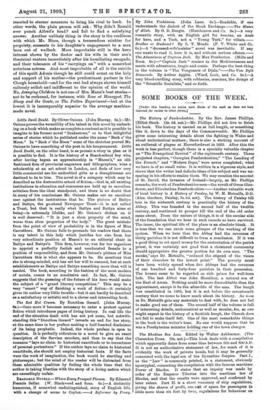SOME BOOKS OF THE WEEK.
[Under this heading we notice such Books of the week as have not bun reserved for review in other forms.]
The History of Pembrokeshire. By the Rev. James Phillips. (Elliot Stock. 12s. 6d. net.)—Mr. Phillips did not live to finish his book. The history is carried on at full length, or something like it, down to the days of the Commonwealth. Mr. Phillips gives some interesting details about the fighting in Wales and about ecclesiastical matters ; there is also a striking account of an outbreak of plague at Haverfordwest in 1653. After this the work is less perfect, though there is a specially valuable chapter on "The Evangelical Revival" of the eighteenth century. Three projected chapters, "Georgian Pembrokeshire," "The Landing of the French," and "Modern Days," were never completed; what we have is of no small value. It is written in a vigorous style, and shows that the writer had definite ideas of his subject and was un- sparing in his efforts to realise them. We may mention the account of St. David, the invasion of Ireland—largely, as Mr. Phillips remarks, the work of Pembrokeshire men—the revolt of Owen Glen- dower, and Elizabethan Pembrokeshire.—A nether valuable work of local history is A History of Paisley, by W. M. Metcalfe, D.D. (Alex. Gardner, Paisley, 7s. 6d. net). The history of Paisley till late in the sixteenth century is practically the history of the Abbey. This was founded in the second half of the twelfth century, and continued to prosper till the end of the old order came about. From the nature of things, it is of the secular side of the foundation that we hear in such records as have survived. The inner, the spiritual life of the place is an absolute blank. . It is true that we can catch some glimpse of the working of the system. When we hear that the Abbey had the revenues of thirty parishes it is not difficult to form a conclusion. If it was a good thing to set apart money for the sustentation of the parish priest, it was certainly not good that a cloistered community should appropriate the greater portion for its own uses. "The monks," says Dr. Metcalfe, "reduced the stipend of the vicars of their churches to the lowest point." The poverty must have been widely spread when five Abbeys had the revenues of one hundred and forty-four parishes in their possession. The houses came to bo regarded as rich prizes for well-born lads. The last Abbot was John Hamilton, a natural son of the Earl of Arran. Nothing could be more discreditable than the appointment, except it be the after-life of the man. The burgh was constituted in 1485, but it is not before the seventeenth century that we come to know much about its history. As soon as Dr. Metcalfe gets any materials to deal with, he does not fail to make good use of them. The second half of the volume is full of interesting details, ecclesiastical as well as secular, for, as one might expect in the history of a Scottish burgh, the Church does not fail to make itself felt. One of the most remarkable things in the book is the writer's tone. No one would suppose that he was a Presbyterian minister holding one of the town charges.






































 Previous page
Previous page